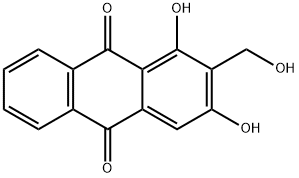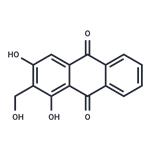ChEBI: Lucidin is a dihydroxyanthraquinone.
lucidin (nsc 30546) is a natural component of rubia tinctorum l., which is mutagenic in bacteria and mammalian cells [1].hydroxyanthraquinones (has) are special organic compounds widely distributed in the plant kingdom. the ha plants have been used as laxatives and colorant for thousands of years. in the last century, has were also employed as medicine for the treatment of kidney stone. lucidin is a ha extracted from the root of rubia tinctorum l. that also known as madder. it was thought to be genotoxic in bacteria and mammalian cells [1].lucidin was found to be mutagenic in five salmonella typhimurium strains without metabolic activation. additionally, in chinese hamster fibroblast v79 cells, lucidin was found to be mutagenic at the hypoxanthine-guanine phosphoribosyl transferase gene locus, which induced dna single-strand breaks and dna-protein cross-link. in primary rat hepatocytes and transformed c3h/ m2-mouse fibroblasts, it was observed lucidin might induce dna repair synthesis [1].in mouse model, when aci rats were treated with 1-10% madder roots in the diet and control group without madder roots for 780 days, the dose-dependent increase of benign and malignant tumors were observed in liver and kidney. additionally, dna adducts were observed in liver, kidney and colon when treated with 10% madder root for two weeks. the formation of dna adducts and mutagenicity was thought to be associated with lucidin which was contained in the madder roots [2].
[1] westendorf j et al. , the genotoxicity of lucidin, a natural component of rubia tinctorum l., and lucidinethylether, a component of ethanolic rubia extracts. cell biol toxicol. 1988, 4(2):225-239.
[2] westendorf j et al. , carcinogenicity and dna adduct formation observed in aci rats after long-term treatment with madder root, rubia tinctorum l. carcinogenesis. 1998, 19(12):2163-2168.



